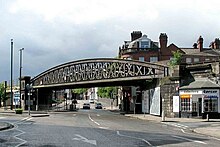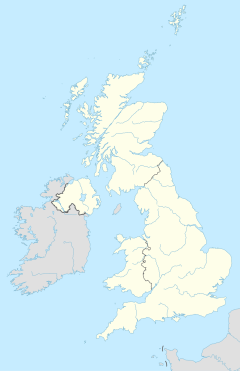Longton, Staffordshire
| Longton | |
|---|---|
| Federated Town and District | |
| |
Location within the United Kingdom | |
| Population | 27,214 |
| OS grid reference | SJ911433 |
| Unitary authority | |
| Ceremonial county | |
| Region | |
| Districts of the town | |
| Post town | STOKE-ON-TRENT |
| Postcode district | ST3 |
| Dialling code | 01782 |
| Police | |
| Fire | |
| Ambulance | |
| UK Parliament | |
Longton is one of the six towns which amalgamated to form the county borough of Stoke-on-Trent in 1910, along with Hanley, Tunstall, Fenton, Burslem and Stoke-upon-Trent in Staffordshire, England. [1]
History
Longton ('long village') was a market town in the parish of Stoke in the county of Staffordshire. The town still has a market housed in an attractively renovated market hall. Longton is an ancient village with hundreds of years of history. It was a long, strangling township (hence its name) for centuries until its population doubled in the space of a decade, the 1960s.[2]
Coal miners in the Hanley and Longton area ignited the 1842 general strike and associated Pottery Riots.[3] The summer of 1842 was a time of riot across the north and midlands of England, including north Staffordshire. The riot impacts employees strike in pottery factories, which were dependent on coal to fire their wares, and many pottery workers had their hours of work reduced, leading to great hardship. On 14 and 15 August 1842 the prominent radical writer and poet, Thomas Cooper, spoke at a number of open-air meetings in Stoke-on-Trent in support of the local colliers entry. Following his speech on 15 August, a number of men marched through Hanley, Shelton, Stoke, Penkhull, Fenton and Longton destroying property and encouraging others to join them. The riots continued through the night and the following morning a large crowd assembled in Burslem.[4]
In March 1865, Longton and Lane End were incorporated as the Borough of Longton. On 1 April 1910, the town was federated into the county borough of Stoke-on-Trent. Longton and Lane-End are two townships, or liberties, forming one flourishing market town now commonly called Longton, and situated at the southern extremity of the Potteries, five miles South East of Newcastle .[5]
Arnold Bennett referred to Longton as Longshaw, one of the "five towns" featured in his novels set in the Staffordshire Potteries.
A shopping precinct, the Bennett Precinct, opened in 1962.[6] It is now named Longton Exchange.

Industry
The district has a long history as a base for the pottery industry, such as Paragon China and Aynsley, and several major manufacturers still have a presence, along with Gladstone Pottery Museum. Roslyn Works, which adjoins the latter, is now home to several small-scale manufacturers of ceramics.
Florence colliery, which opened in the 19th century, was one of the pits of the North Staffordshire Coalfield. It was connected underground to another pit at Hem Heath. It was closed in the 1990s.
Belstaff Clothing brand
Belstaff of Longton is a garment manufacturer best known for producing high-performance waterproof jackets.
Founded in Longton in 1924 by Eli Belovitch and his son in law Harry Grosberg. Belstaff produced all-weather jackets for motorcyclists, and was the first company to use waxed cotton.
Landmarks
Public buildings
Longton Town Hall, which was completed in 1844 and was the local seat of government until 1910, was being stripped out by contractors when it was saved from demolition in 1986.[7]
Industrial buildings

There are fewer than 50 surviving bottle ovens in the city of Stoke-on-Trent (and only a scattering elsewhere in the UK). The kilns of the Gladstone Pottery Museum, along with others in the Longton conservation area represent a significant proportion of the national stock of the structures.[8] The bottle ovens of Longton have been promoted as a tourist attraction.[9] In the 21st century, the condition of some of the bottle ovens has given cause for concern. A Stoke-on-Trent Ceramic Heritage Action Zone was created with the double function of regenerating Longton and surviving bottle ovens throughout the city.[10][11]
Transport
In 1997 Longton's one-way system was bypassed when a new section of the A50 was opened. It runs from Blythe Bridge to Queensway (a section of the A500), going through Longton in a cutting.

Longton is served by a railway station on the Crewe–Derby line. It was opened by the North Staffordshire Railway on 7 August 1848. A new bus interchange was opened adjacent to it in 2003 on the site of a former Co-op supermarket.

Education
Secondary schools in the area include St Thomas More Catholic Academy and Stoke Studio College.
Together with Rochdale, then in Lancashire, Longton was host to the first Workers' Educational Association tutorial classes. R. H. Tawney, known as "the patron saint of adult education",[13] taught the classes for three years starting in January 1908.
Nightlife
Jollees Cabaret Club was a very popular nightspot in the 1970s, attracting some of the biggest names in entertainment. In the early 1990s, Shelley's Laserdome became widely known throughout the Midlands as a rave venue, but it was forced to close in 1992.
Notable people
- Sir John Edensor Heathcote (c.1757–1822) Stoke-on-Trent industrialist, owner of Longton Hall, which he rebuilt in 1778.
- John Aynsley (1823–1907) English potter who established the Portland Works in Longton
- Margaret Sherratt Keys (1856-1942) , British-born American artist, china painter, store proprietor
- Percy Shelley (1860-1937) was a major force in developing Shelley Potteries, born in Longton
- Frederick Arthur Challinor (1866–1952), English composer[14][15]
- Ernest Albert Egerton (1897–1966) English recipient of the Victoria Cross
- William Thomas Astbury } (1898–1961) English physicist and molecular biologist who made pioneering X-ray diffraction studies of biological molecules
- Gordon Mons Higginson (1918-1993) British purported spiritualist medium.
- Charles Tomlinson (1927–2015) English poet, attended Longton High School
- Freddie Jones (1927–2019) actor; his many roles on film and television included Sandy Thomas in Emmerdale.
- Andrew Evans (born 1950s) a soldier from Longton, stationed at Whittington Barracks, was wrongfully convicted and served 25 years in custody after confessing to the 1972 murder of Judith Roberts, a 14-year-old schoolgirl from Tamworth.
Sport
- William (Billy) Weston (1847-1935) Australasian billiards player, emigrated from Longton aged 3.
- George Arthur Gallimore (1886–1949) English professional footballer who made 77 appearances for Stoke City F.C.
- Henry "Harry" Colclough (1888–1955) English international footballer, who made 83 appearances for Crystal Palace F.C.
- William Wootton (1904–2000) English footballer, made 56 appearances for Port Vale F.C.
- Norman Henry Hallam (1920–1997) was an English footballer, made 63 appearances for Port Vale F.C.
- Philip Adrian "Phil" Heath (born 1964) former professional English footballer, made 297 appearances.
Trivia
- Longton is the birthplace and home of Alan Povey's character Owd Grandad Piggott
Gallery
- Sutherland Institute, Longton. Completed in 1898 on land donated by the Duke of Sutherland who lived at nearby Trentham Hall.
- The work of potters is depicted in the terracotta frieze above the entrance to the Sutherland Institute.[12]
- Gladstone Pottery Museum
- Longton Park
References
- ^ Web Editorial Team, British History Online. "The Federation Of The Six Towns". BHO. Retrieved 9 December 2023.
- ^ Searson, M. (1988) Longton a Village History, Lancaster: Carnegie Press, p.2-3.
- ^ Web Editorial Team, Genealogy Reviews. "Stoke-on-Trent". Genealogy Reviews. Retrieved 23 January 2024.
- ^ Web Journalism Team, Stoke Museum (19 September 2019). "The Pottery riots in Burslem, August 1842". Stoke Museum. Retrieved 23 January 2024.
- ^ Web Journalism Team, Stoke Museum. "Land End". The Potteries. Retrieved 30 January 2024.
- ^ Abberley, John (2003). The Way We Were in the 1960s: Memories of Staffordshire in Photographs. Altrincham: Hochland Communications Ltd. ISBN 1-904038-07-7.
- ^ "From Sentinel legend John Abberley's archive we look at Longton's Town Hall". Stoke Sentinel. 30 October 2018. Retrieved 20 January 2021.
- ^ "Longton Conservation Area" (PDF). 2009. Retrieved 1 December 2014.
- ^ "| Stoke-on-Trent". www.stoke.gov.uk.
- ^ "Stoke-on-Trent Ceramic Heritage Zone". Historic England.
- ^ Corrigan, Phil (October 2020). "£800,000 scheme to 'transform' historic town centre buildings". Sentinel. Retrieved 6 January 2021.
- ^ a b "Listed buildings in Stoke-on-Trent".
- ^ Elsey, B. (1987) 'R. H. Tawney – Patron saint of adult education', in P. Jarvis (ed.) "Twentieth Century Thinkers in Adult Education", Beckenham: Croom Helm
- ^ "Frederick Arthur Challinor". www.hymntime.com.
- ^ "Frederick A. Challinor | Hymnary.org". hymnary.org.
External links
- Make it Stoke-on-Trent – Longton Regeneration (listings of local amenities and regeneration projects)
- Longton – Stoke-on-Trent
- Longton
- Gladstone Pottery Museum
- Use interactive maps to find historic photographs and artefacts of old Longton
- Town profile at The Sentinel (local newspaper)
- Longton South Community Blog (local blog)
- www.hylands.tv










![The work of potters is depicted in the terracotta frieze above the entrance to the Sutherland Institute.[12]](https://upload.wikimedia.org/wikipedia/commons/thumb/3/34/Section_of_frieze_above_entrance_to_Sutherland_Institute%2C_Longton_-_geograph.org.uk_-_345925.jpg/120px-Section_of_frieze_above_entrance_to_Sutherland_Institute%2C_Longton_-_geograph.org.uk_-_345925.jpg)


